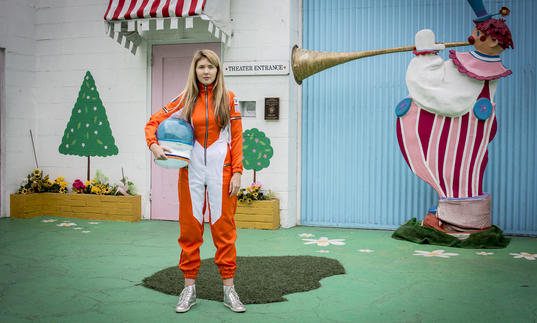Lisa Hannigan + s t a r g a z e
This performance will begin promptly at 7.30pm
Running time: 1 hours 15 minutes
There will be no interval in this performance
Timings are approximate and subject to change

Martin Aston speaks to Lisa Hannigan about how she found a new, more spacious sound on her most recent record On Swim and why working with s t a r g a z e felt like a trip to sea.
The first time Lisa Hannigan collaborated with an orchestra, she found the experience, ‘incredibly exciting, because of the sheer of the sound and feeling, but also nerve-wracking. Playing my songs sometimes feels like a tiny rowboat muddling along, and then this ocean liner comes along that I’m desperately trying not be run over by!’
By comparison, the Dubliner’s live work with s t a r g a z e - the northern European orchestral collective typically numbering 12 or 13 - is more manageable, yet equally exciting, going by their live collaborations, starting at the Cork Opera House in 2015 and most recently at Berlin’s PEOPLE festival in June 2018. ‘When I first rehearsed with s t a r g a z e,’ Hannigan recalls, ‘they were sitting in a circle, facing each other, and as they started to play my song, it was like they all climbed into my tiny boat.’
Hannigan’s aquatic metaphors mirror her deep love for the ocean, which fed into the titles of her 2008 debut Sea Sew and her most recent album, 2016’s At Swim (2011’s intervening album was titled Passenger). Sea Sew was recorded after Hannigan had spent six years in Damien Rice’s band, principally as backing singer (but occasionally guitar, bass or drums), and represented a period of freedom and independence; consequently, the album was a burnished, lighter take on the folk- melancholic sound at the heart of Hannigan’s work. Waving, not drowning then. At Swim, however, sounds quite the opposite: spectral, stark and weighty, as if she was drowning in her emotions.
As Hannigan explains, the title At Swim acknowledges one of her favourite novels, Flann O'Brien’s At-Swim-Two-Birds, but it more closely described her state of mind. Having toured Passenger for two years, ‘I was living between houses and countries, and didn’t know what to do with myself,’ she says. A move to London, to change her circumstances and hopefully kickstart a new album, backfired. ‘I found the city isolating compared to Dublin; I had great people around me so it was probably coming from myself,’ she ventures. ‘I just couldn’t plug into anything. Too often, songwriting felt like work. It’s like pastry, you can’t work it too much or it ends up too tough. At Swim sums up the feeling of being adrift, lost from myself and from anything solid and real, not knowing where land was.’
Then, to Hannigan’s amazement, land ahoy! Or rather, Aaron Dessner of The National, who emailed her, out of the (big) blue, offering to collaborate. ‘To this day, I’ve never asked Aaron why! Maybe it’s something banal, like a playlist – though we’ve both worked with the Australian band Luluc. As a National fan, and of Aaron’s productions, I was blown away by this good fortune. His enthusiasm and his love of making music was an open window to my stale process, and I started seeing things in a different light.’
Dessner produced At Swim while co-writing three (‘Lo’, ‘Ora’ and ‘Barton’) of the album’s eleven songs, playing multiple instruments and organising the session musicians, including s t a r g a z e founder/conductor André de Ridder on violin and string arrangements. Dessner encouraged Hannigan to abandon instrumental ballast. ‘Initially, I was afraid to sound stark,’ she says, ‘but over time, I realised it was the right expression for the songs. Aaron taught me a lot about judicious textural approaches and atmosphere, as opposed to how I’d always heard arrangements, as contrapuntal melodies working off each other.’
Dessner brought some of The National’s unmistakeable sombre gravitas, but Hannigan contributed just as many stark, dark hues. For example, ‘Lo’ and ‘Prayers For The Dying’ respectively addressed the dread of insomnia and the loss of a friend’s parent after a lengthy marriage. And while Sea Sew had a song called ‘Splishy Splashy’, At Swim included the likes of ‘We, The Drowning.’
Hannigan’s writing block even extended to words, so she set Anahorish by Irish poet Seamus Heaney to music (‘it looked like a song on the page, the way it’s divvied up’). Of the two new songs being played tonight (added to a selection of songs from Hannigan’s three albums, with an emphasis on At Swim), ‘Swan’ has words (at her request) by Irish playwright Enda Walsh.
Hannigan clearly loves collaboration; solo voyages, after all, can be lonely endeavours. De Ridder and s t a r g a z e love collaboration too. Driven by ‘what’s going on in contemporary pop, electronica and other uncategorisable genres in and around these confines,’ the collective has worked with the likes of Owen Pallett, Villagers, Matthew Herbert, Terry Riley and Deerhoof, and have performed songbooks by Sufjan Stevens, Mica Levi and Boards Of Canada, while previous Barbican performances include collaborations with Julia Holter, Nils Frahm and POLIÇA.
Both parties are happy, compatible co-voyagers. Hannigan appreciates De Ridder for his, ‘lightness of touch and sense of movement. He really understands my songs.’ In turn, de Ridder notes Hannigan’s, ‘pure enthusiasm and appreciation for her collaborators' efforts, an artistic generosity towards experimentation. Yet Lisa always knows what she wants and keeps the essence of the song in the most charming manner.’
Together, the Barbican is in for a special evening. No lifejackets required.
This performance will begin promptly at 7.30pm
Running time: 1 hours 15 minutes
There will be no interval in this performance
Please note timings are approximate and subject to change
In an effort to be more sustainable, and in the spirit of The Art of Change, this digital programme is part of a trial we are conducting to discontinue printed freesheets.
Performers
Mew are:
Jonas Bjerre Terkelsbol vocals,guitar
Johan Wohlert bass
Mads Wegner guitar
Silas Jorgensen drums
Nicholas Watts keyboards
TBC violin
TBC viola
TBC cello
TBC double bass
Discover

Listen: Lisa Hannigan - At Swim
Listen to At Swim, the third studio album by Irish singer/songwriter Lisa Hannigan.
You might also like...

+ Kathryn Joseph

From Space Beams to Anti-Streams
Barbican Hall
Location
The Barbican Hall is located within the main Barbican building. Head to Level G and follow the signs to find your seating level.
Address
Barbican Centre
Silk Street, London
EC2Y 8DS
Public transport
The Barbican is widely accessible by bus, tube, train and by foot or bicycle. Plan your journey and find more route information in ‘Your Visit’ or book your car parking space in advance.
We’ve plenty of places for you to relax and replenish, from coffee and cake to wood-fired pizzas and full pre-theatre menus
Mobility
Spaces for wheelchair users in row U at the rear of the stalls (up to sixteen, depth of row 180cm) and the back row of the circle (four), both with fold-down companion seats. Some seats in row S of the stalls for people with very limited mobility.
Assistance dogs
Assistance dogs may be taken into the concert hall where there are a limited number of suitable seats in row G of the stalls. If you prefer, you may leave your dog with a member of the cloakroom staff during the performance.
Hearing facility
There is an induction loop in the concert hall. You can use this by adjusting your hearing aid to the ‘T’ setting.
Free large-print programmes
These are available for most of our concerts. Please contact [email protected] at least a week beforehand, to prebook a large-print programmme.
For more access information, please visit our Accessibility section.
Plan your visit
Meet friends, grab a drink, drop in to one of the free installations on Level G before the show - here's what else is happening at the Barbican when you visit.









